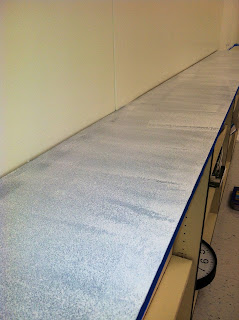This is a lot. The past three days I've recruited some help for the sanding stage, but my partner was not exactly reliable.
After wearing three pads of 150 grain sandpaper down to the nub, I was finally to start spackling some of the larger holes and imperfections in the wall.

And then the real mess began. I'm a pretty solid painter, in terms of a solid finished product, but I tend to wear a good amount all over me by the end of the day. I better be a tad more careful with the IdeaPaint.
It was a lot of work, but it was good to finally get the rollerbrush rollin.' I was pretty satisfied with the results, but will probably put on a second coat before the final sanding just to ensure a good writing surface.Speaking of which, I'm a tad nervous about the smoothness/performance of the drywall, even though I've been reassured by IdeaPaint and by others that drywall is actually surprisingly "writable" with the proper sanding and priming. I guess the little bumps and knobs attendant with drywall make me anxious, but given the number of corporations and schools with IdeaPaint which undoubtedly use drywall, I'd be shocked if it ended up being an issue.
I also began to prime the top of the bookcase at the back of the classroom, and it's going to need three or four coats of primer, because it seems to be TOO smooth; it gets better with each application, though.
Thus far, some tips for those considering this for their classroom;
A) Be patient. The prep work is much more laborious than the actual application of the product. If you're anything like me, the moment you get the IdeaPaint by delivery you're ready to crack open a can and get going. Unless you opt for the more expensive IdeaPaint Create series, you're going to have a long period between receiving your product and applying it, and even Create has some prep work involved.
B) Recruit some help for the sanding; this was a massive undertaking to do myself. Also, get a lot of sandpaper. It goes quickly. I prefer the 150 grain.
C) Make sure you coordinate very well with your custodial staff; the staff at Eastside was stripping and waxing the hallway while I was in my room working, and I got "waxed" in at one point. This is also an especially important point given that many schools and districts paint and move furniture in the "off-season," and it's easily foreseeable someone's brand new dry erase surface getting messed up.
Still waiting on some good practices, procedures and strategies, guys!





No comments:
Post a Comment